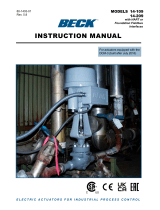Page is loading ...

RTC 300
sCAN
Installation instructions
4189350071B

1. sCAN
1.1 Introduction.....................................................................................................................................................................................................................................3
1.2 Set up and adjust the RTC.....................................................................................................................................................................................................4
1.3 RTC 300 wiring............................................................................................................................................................................................................................5
1.4 Change the node ID with wires..........................................................................................................................................................................................5
1.5 Set a new zero value with wires........................................................................................................................................................................................ 6
1.6 Changing direction CW/CCW with wires.................................................................................................................................................................... 6
Installation instructions 4189350071B EN Page 2 of 6

1. sCAN
1.1 Introduction
The RTC 300 is 16-bit angle transmitter with CAN bus interface, supporting CANopen.
Connection diagram of 2 XL sCAN (16-bit) indicators and one RTC 300.
Installation instructions 4189350071B EN Page 3 of 6

1.2 Set up and adjust the RTC
The RTC is a 360° measuring device (encoder). It measures the full ±180° represented by a 16-bit signed value transmitted
on the CAN bus. The 16-bit data value is placed in bytes of 0 and 1 in TPDO1 of the selected CAN node ID (COB-ID:
0x180+NodeID).
Default settings:
1. Node ID 1 = angle data is transmitted in TPDO with COBID 0x181.
2. The direction is clockwise (CW). To increase the measured angle value, turn the shaft to the right. To decrease the
measured value, turn the shaft to the left.
XL sCAN indicator connection
Pin number Function Note
1 Supply voltage 0 V Consumption max 150 mA.
2 Supply voltage 24 V Consumption max 150 mA.
3* CAN connection CAN 1 H input CAN 1 line (sCAN line).
4* CAN connection CAN 1 L input CAN 1 line (sCAN line).
5* CAN connection CAN 1 GND CAN 1 line (sCAN line).
6 CAN connection Not used
7 CAN connection Switch/button Used for setting of min/
zero/max with external switch.
8 CAN connection GND Used for setting of min/
zero/max with external switch.
9 Illumination, analogue,
dimmer NC
Dimmer input. Dimmer range 7
to 30 V DC.
Consumption max. 30 mA.
10 Illumination, analogue,
dimmer Illumination GND
Dimmer input. Dimmer range 7
to 30 V DC.
Consumption max. 30 mA.
11 Illumination, analogue,
dimmer Illumination +
Dimmer input. Dimmer range 7
to 30 V DC.
Consumption max. 30 mA.
NOTE * CAN 1 GND is a common wire specified in CANopen. It is not a cable shield. If the CAN bus cable does not contain
a CAN common wire, then do not connect the CAN 1 GND.
XL wiring
NOTE You can only install two terminations at a time on a CAN bus network.
Installation instructions 4189350071B EN Page 4 of 6

1.3 RTC 300 wiring
Wire Marking Signal Remark
Blue 0 V Supply voltage 18 to 32 V DC at max. 60
mA.
Red 24 V DC Supply voltage 18 to 32 V DC at max. 60
mA.
Green CAN high CAN bus Remember to terminate the
CAN bus.
Yellow CAN low CAN bus Remember to terminate the
CAN bus.
White S1 Setup Setup wires.
Normal operation: All four
setup wires must be
connected to 0 V (blue).
Grey S2 Setup
Pink S3 Setup
Brown S4 Setup
1.4 Change the node ID with wires
You can change the CAN node ID using the four setup wires in the cable. You can change the ID to a number between 1 and
8.
How to change the CAN node ID
1. Remove the 24 V power supply.
2. Use the Node ID table below for how to connect the wires for each node ID.
3. Make sure that S4 (brown) is open (not connected).
4. Apply 24 V power to the RTC and wait 5 seconds (3 to 30 sec).
5. Connect S4 (brown) to 0 V (blue) for 5 seconds (3 to 10 sec).
6. Disconnect S4 (brown) for more than 1 second. The new CAN node ID is now selected and stored.
7. Connect all four setup wires to 0 V (blue). The RTC runs in normal operation mode.
Node ID
S1
White
S2
Grey
S3
Pink
S4
Brown
0 V
Blue
1 ● - - - ●
2 - ● - - ●
3 ● ● - - ●
4 - - ● - ●
5 ● - ● - ●
6 - ● ● - ●
7 ● ● ● - ●
8 - - - - ●
Normal operation ● ● ● ● ●
Example
To change the CAN node ID to ID 3, connect S1, S2, and 0 V.
Installation instructions 4189350071B EN Page 5 of 6

NOTE Make sure that the 24 V supply is not interrupted during the last steps in the setup procedure when data is stored.
This might damage the RTC.
1.5 Set a new zero value with wires
During normal operation, it is possible to change the angular zero position to be the new angle of the shaft.
1. Set the rudder or azimuth transmitter in the physical zero position.
2. Disconnect all four setup wires, S1 (white), S2 (grey), S3 (pink), and S4 (brown) from 0 V (blue).
3. Connect S1 (white) and S4 (brown) to 0 V (blue) for 5 seconds (3 to 10 sec).
4. When both S1 (white) and S4 (brown) are released, the new zero is set.
5. Connect all four setup wires to 0 V (blue) and the RTC runs run in normal operation mode.
NOTE Make sure that the 24 V supply is not interrupted during the last steps in the setup procedure when data is stored.
This might damage the RTC.
1.6 Changing direction CW/CCW with wires
During normal operation, it is possible to change the measuring direction from CW clockwise (default) to CCW
counterclockwise.
CCW counterclockwise
1. Disconnect all four setup wires from 0 V (blue).
2. Connect S3 (pink) and S4 (brown) to 0 V (blue) for 5 seconds (3 to 10 sec).
3. When both S3 (pink) and S4 (brown) are released, the encoder is in CCW mode.
4. Connect all four setup wires to 0 V (blue), and the RTC runs in normal operation mode.
CW clockwise
1. Disconnect all four setup wires from 0 V (blue).
2. Connect S2 (grey) and S4 (brown) to 0 V (blue) for 5 seconds (3 to 10 sec).
3. When both S2 (grey) and S4 (brown) are released, the encoder is in CW mode.
4. Connect all four setup wires to 0 V (blue), and the RTC runs run in normal operation mode.
NOTE Make sure that the 24 V supply is not interrupted during the last steps in the setup procedure when data is stored.
This might damage the RTC.
Installation instructions 4189350071B EN Page 6 of 6
/







